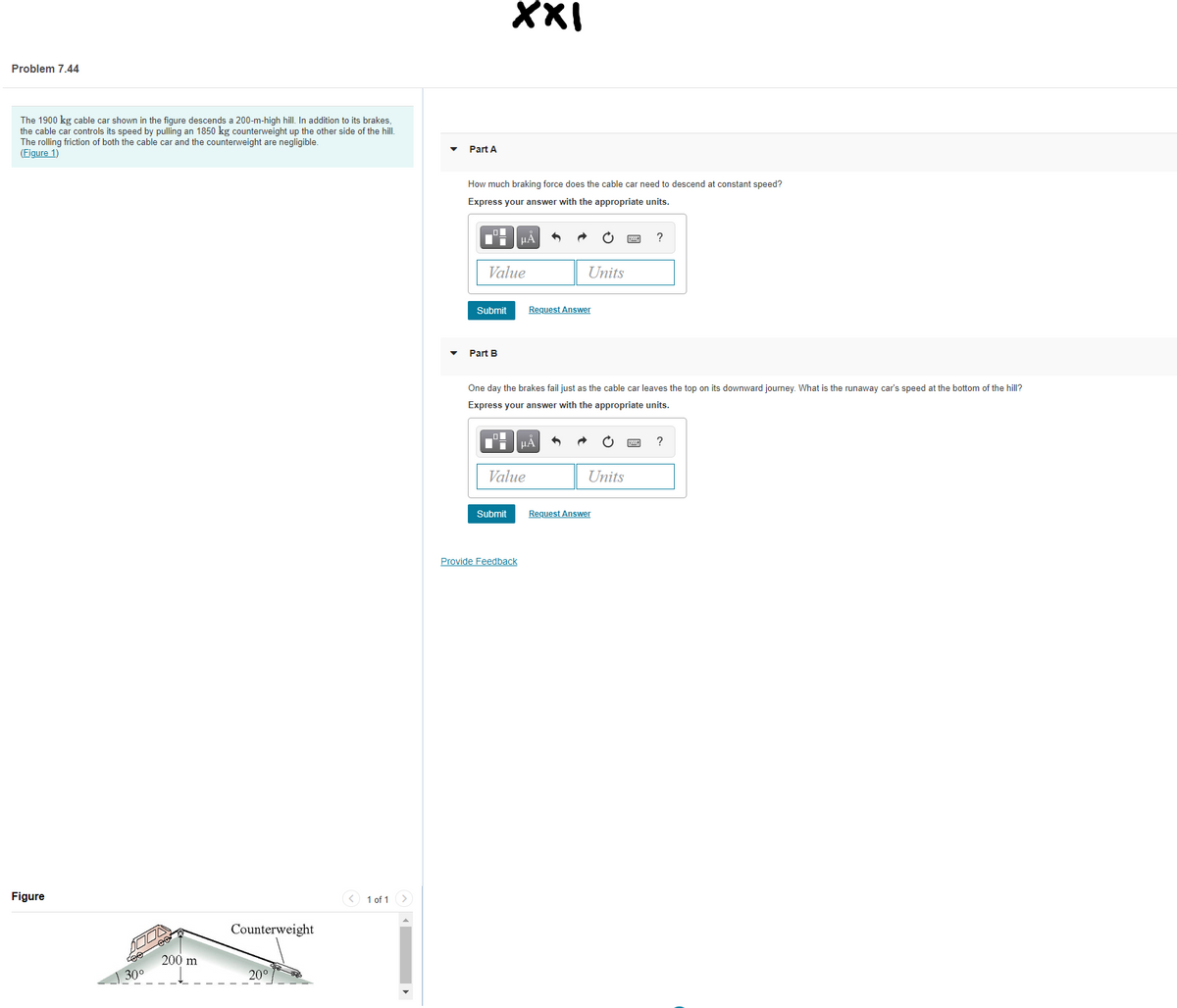The 1900 kg cable car shown in the figure descends a 200-m-high hill. In addition to its brakes, the cable car controls its speed by pulling an 1850 kg counterweight up the other side of the hil. The rolling friction of both the cable car and the counterweight are negligible. (Elgure 1) • Part A How much braking force does the cable car need to descend at constant speed? Express your answer with the appropriate units. Value Units Submit Request Answer • Part B One day the brakes fail just as the cable car leaves the top on its downward journey. What is the runaway car's speed at the bottom of the hill? Express your answer with the appropriate units. Value Units Submit Request Answer
The 1900 kg cable car shown in the figure descends a 200-m-high hill. In addition to its brakes, the cable car controls its speed by pulling an 1850 kg counterweight up the other side of the hil. The rolling friction of both the cable car and the counterweight are negligible. (Elgure 1) • Part A How much braking force does the cable car need to descend at constant speed? Express your answer with the appropriate units. Value Units Submit Request Answer • Part B One day the brakes fail just as the cable car leaves the top on its downward journey. What is the runaway car's speed at the bottom of the hill? Express your answer with the appropriate units. Value Units Submit Request Answer
Physics for Scientists and Engineers with Modern Physics
10th Edition
ISBN:9781337553292
Author:Raymond A. Serway, John W. Jewett
Publisher:Raymond A. Serway, John W. Jewett
Chapter5: The Laws Of Motion
Section: Chapter Questions
Problem 40AP: A 1.00-kg glider on a horizontal air track is pulled by a string at an angle . The taut string runs...
Related questions
Question

Transcribed Image Text:XXI
Problem 7.44
The 1900 kg cable car shown in the figure descends a 200-m-high hill. In addition to its brakes,
the cable car controls its speed by pulling an 1850 kg counterweight up the other side of the hill.
The rolling friction of both the cable car and the counterweight are negligible.
(Figure 1)
Part A
How much braking force does the cable car need to descend at constant speed?
Express your answer with the appropriate units.
HA
?
Value
Units
Submit
Request Answer
Part B
One day the brakes fail just as the cable car leaves the top on its downward journey. What is the runaway car's speed at the bottom of the hill?
Express your answer with the appropriate units.
HA
?
Value
Units
Submit
Request Answer
Provide Feedback
Figure
< 1 of 1 >
Counterweight
200 m
300
20°
Expert Solution
This question has been solved!
Explore an expertly crafted, step-by-step solution for a thorough understanding of key concepts.
This is a popular solution!
Trending now
This is a popular solution!
Step by step
Solved in 4 steps with 7 images

Recommended textbooks for you

Physics for Scientists and Engineers with Modern …
Physics
ISBN:
9781337553292
Author:
Raymond A. Serway, John W. Jewett
Publisher:
Cengage Learning

Physics for Scientists and Engineers
Physics
ISBN:
9781337553278
Author:
Raymond A. Serway, John W. Jewett
Publisher:
Cengage Learning

Principles of Physics: A Calculus-Based Text
Physics
ISBN:
9781133104261
Author:
Raymond A. Serway, John W. Jewett
Publisher:
Cengage Learning

Physics for Scientists and Engineers with Modern …
Physics
ISBN:
9781337553292
Author:
Raymond A. Serway, John W. Jewett
Publisher:
Cengage Learning

Physics for Scientists and Engineers
Physics
ISBN:
9781337553278
Author:
Raymond A. Serway, John W. Jewett
Publisher:
Cengage Learning

Principles of Physics: A Calculus-Based Text
Physics
ISBN:
9781133104261
Author:
Raymond A. Serway, John W. Jewett
Publisher:
Cengage Learning

Physics for Scientists and Engineers: Foundations…
Physics
ISBN:
9781133939146
Author:
Katz, Debora M.
Publisher:
Cengage Learning

Glencoe Physics: Principles and Problems, Student…
Physics
ISBN:
9780078807213
Author:
Paul W. Zitzewitz
Publisher:
Glencoe/McGraw-Hill

Classical Dynamics of Particles and Systems
Physics
ISBN:
9780534408961
Author:
Stephen T. Thornton, Jerry B. Marion
Publisher:
Cengage Learning